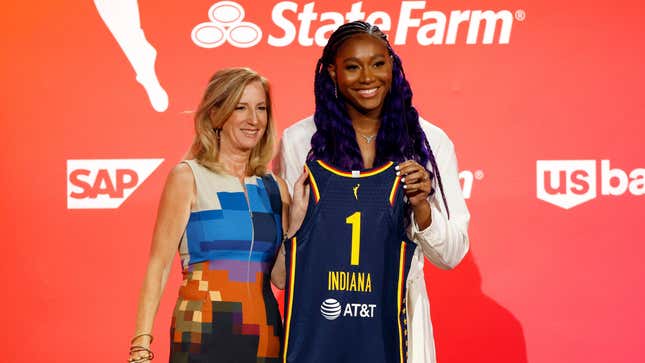The 2023 WNBA Draft Raked in Most Viewers Since 2004
The players of the WNBA have always been stars. Now, new audiences are getting a real chance to see them.
EntertainmentEntertainment

On Monday night, the top draft prospects for the WNBA gathered for the 2023 draft—the league’s kickoff to the upcoming season and now a glitzy spectacle in its own right. UConn’s Dorka Juhasz, who was later drafted by the Minnesota Lynx, wore a Versace corseted dress on the league’s signature orange carpet; inside women slung basketball purses doused in Swarovski crystals; invitees guzzled champagne and inhaled tiny tacos beneath strobe lights. With first-round picks like Aaliyah Boston, Diamond Miller, Jordan Horston, and Zia Cooke—players who’ve been dubbed “generational talent,” “flavors of greatness,” the ability to become “franchise centerpieces”—the entire evening oozed star power. It felt something like momentum.
On Tuesday night, ESPN dropped the statistics to prove that momentum: The 2023 WNBA draft averaged 572,000 viewers, up 42% year-over-year, making it the most-viewed WNBA Draft since 2004 and the second-most viewed draft on record. And according to league PR and ESPN, the WNBA credentialed 175 media members for this year’s draft, nearly triple the 65 credentials given in 2022.
That news comes on the heels of a historic NCAAW March Madness tournament, in which the women’s championship matchup between LSU and Iowa averaged 9.9 million viewers—more than any women’s college basketball game on record. It’s proof that the onramp from NCAA women’s basketball into the professional league doesn’t just exist, but is beginning to thrive: The hype is transferring over, at least in part, and that’s music to the WNBA’s ears.
This success is due, in part, to college players benefitting from NIL deals (a two-year-old policy passed by the NCAA that allows college athletes to profit financially from their Name, Image, and Likeness). “I was wrong about [NIL]. I thought it’d be just another place for women to be undervalued in sports,” WNBA Commissioner Cathy Engelbert told reporters in attendance Monday evening. “I went from the Final Four in Dallas to the Master’s, and everyone at the Master’s was talking about women’s basketball. It was pretty incredible.
-

-

-

-

-

-

-

-

-

-

-

-

-

-

-

-

-

-

-

-

-

-

-

-

-

-

-

-

-

-

-

-

-

-

-

-

-

-

-

-








































